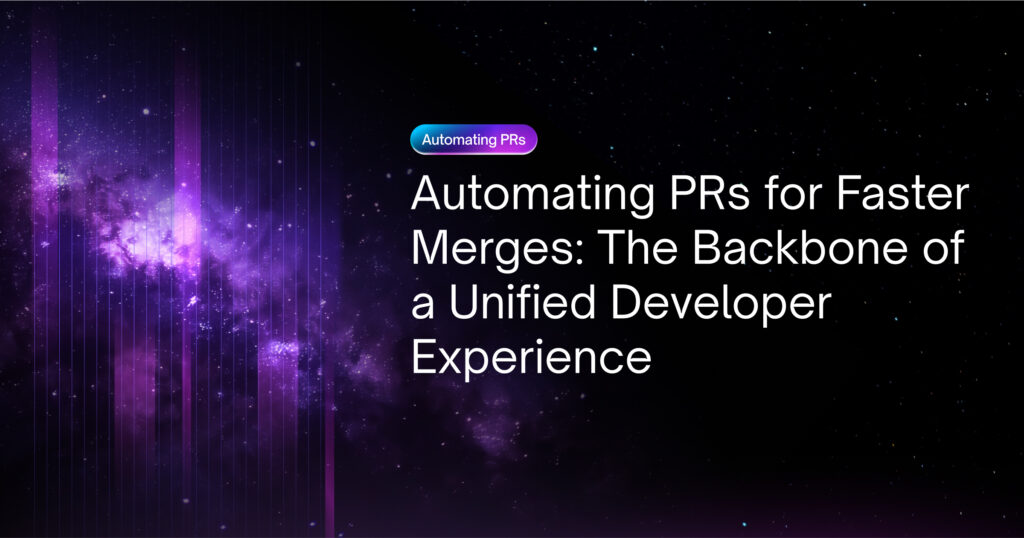
1. The PR Bottleneck: Dev Teams’ Most Expensive Delay
Every engineering team knows the pain. Your code is done, tests are green, and you’re ready to ship. But your pull request (PR)? Stuck in review limbo.
Sometimes it’s waiting on a teammate who’s out sick. Other times, it’s blocked by a late-breaking compliance requirement. And more often than not, it’s just lost in the chaos of overlapping priorities and scattered tools.
This isn’t just a speed bump, it’s a full stop. Merge delays cost teams momentum, degrade developer experience, and extend time-to-value. According to GitHub’s 2022 Octoverse report, the average time to merge a PR was over 2 days. For fast-scaling companies, that’s an unacceptable lag.
Beyond the immediate frustration, delays in PRs also introduce cascading risks:
- Merge conflicts increase the longer a branch lingers.
- Context decay as original intent fades from memory.
- Quality drift when rushed reviews slip in critical issues.
It’s time for a better way.
2. Why Automating PRs Is the Real DevEx Superpower
Developer experience (DevEx) isn’t just about flashy dashboards or slick UIs. It’s about removing friction from the flow of work. Few things are more friction-heavy than manual, inconsistent PR processes especially when compounded by compliance and security requirements.
PR automation delivers tangible DevEx gains:
- Reduces context-switching for reviewers.
- Removes bottlenecks caused by manual processes.
- Enforces quality and security without slowing down velocity.
- Eliminates YAML fatigue, developers don’t need to learn or maintain complex pipeline configurations.
- Works via CLI or GUI, letting engineers choose the workflow that fits their style.
In regulated or high-growth environments, these benefits compound. For instance, a FinTech team using Revolte reduced compliance-related PR review time by 63% through automation. That’s not a nice-to-have; it’s a competitive advantage.
Developer experience (DevEx) isn’t just about flashy dashboards or slick UIs. It’s about removing friction from the flow of work. Few things are more friction-heavy than manual, inconsistent PR processes, especially when compounded by compliance and security requirements.
PR automation delivers tangible DevEx gains:
- Reduces context-switching for reviewers.
- Removes bottlenecks caused by manual processes.
- Enforces quality and security without slowing down velocity.
In regulated or high-growth environments, these benefits compound. For instance, a FinTech team using Revolte reduced compliance-related PR review time by 63% through automation. That’s not a nice-to-have; it’s a competitive advantage.
3. What an Ideal PR Automation Workflow Looks Like
Let’s paint the picture:
- A developer pushes a branch. Revolte kicks off pipeline validations instantly.
- Linting, unit tests, and SAST (static analysis) run concurrently.
- AI agents scan for code smells, regressions, and risky diffs using trained heuristics and historical context.
- PR metadata (file types, scope, dependencies) determines who reviews what automatically.
- Conditional quality gates decide merge-readiness (e.g., all critical paths must have 2 approvals; security-impacting changes must pass CVE scan).
By the time a human reviews it, they’re not starting from scratch, they’re validating what’s already been pre-cleared. This transforms PRs from manual rituals into intelligent, scalable workflows.
4. How Revolte Automates PRs with Agentic Intelligence
Revolte takes the promise of PR automation and amplifies it through agentic workflows:
- Context-aware AI Reviewers: Not just linting. Revolte’s agents understand previous merges, common reviewer feedback, and project-specific patterns.
- Dynamic Approval Routing: PRs touching critical modules get escalated; doc changes bypass senior reviewers. Your process evolves with your codebase.
- Real-Time Policy Enforcement: From SOC2 to HIPAA, compliance checks are applied automatically at the right step,no checklist needed.
And the best part? It all integrates with your existing GitHub/GitLab setup, so teams don’t have to change how they work, just how well they work.
5. The ROI: Speed, Stability, and Sanity
When we talk about automating PRs, it’s not about shaving a few minutes. It’s about unleashing a new velocity tier for your team.
Here’s what we’ve seen from Revolte users:
- 42% faster time-to-merge on average
- 34% fewer PR rejections due to early AI flagging
- 50% drop in post-merge incidents, driven by agent-enforced quality gates
And these numbers translate into strategic benefits:
- Product launches on schedule
- Reduced burnout for reviewers
- Higher throughput from the same team headcount
6. Beyond Automation: Towards a Unified Dev Experience
PR automation is a lever. When integrated into a unified cloud platform like Revolte, it becomes a flywheel:
- CI/CD is faster because builds kick off immediately from clean, validated branches.
- Observability improves because every merged PR is tagged with context-rich metadata.
- Infra teams get fewer surprises because infra-as-code PRs follow the same gated rigor.
This unified experience isn’t just smoother, it’s safer, faster, and more sustainable.
7. Try Revolte Today: Automate Smarter, Merge Faster
If your team is still relying on manual PRs, you’re burning time, trust, and talent.
With Revolte, you can:
- Book a demo to see agentic PRs in action.
- Automate your merge process in under an hour.
- Start scaling development without scaling overhead.
Because shipping faster should never mean shipping blind.
Start your free trial or book a demo today.